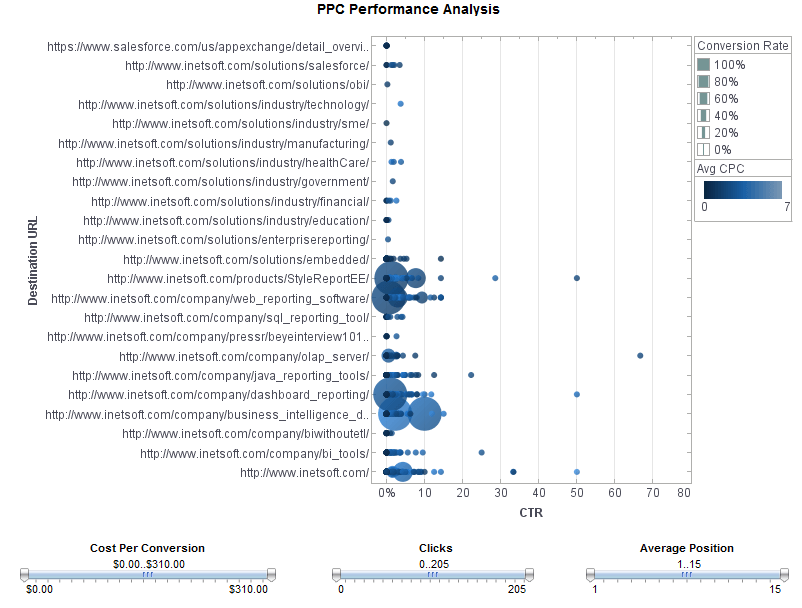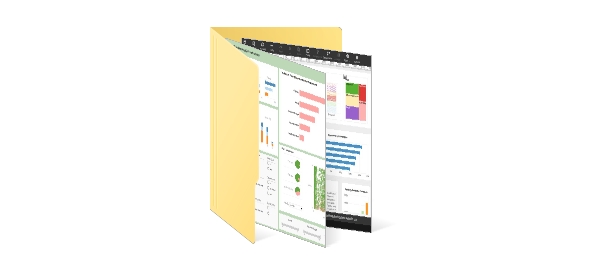Dashboards and Visualizations for Google Ads and Analytics
InetSoft's business intelligence dashboarding software connects to Google Adwords and Analytics data so that you can create interactive data visualizations to better analyze the vast amounts of performance data the two applications collect. In addition, you get better KPI dashboarding with a Web-based drag-and-drop design tool that lets you chart any data including custom conversion types.
Google provides good basic dashboards and drill-down reporting features, but they are quite limiting when compared to a professional dashboard reporting solution like InetSoft's. Particularly when analyzing multiple dimensions in large data sets such as your Web site traffic and PPC advertising performance, you need more flexibility and interactivity.
With an easy-to-use visualization designer, you can quickly add selection lists, range sliders and calendar selectors to build an efficient way to monitor and explore your data. Even more powerful is the ability to mash up this data with other data in your enterprise, particularly your CRM data where lead and sales data are stored. Now you can track KPIs like CPL (cost per lead), CPO (cost per opportunity), and most importantly ROI (sales revenue associated with campaigns and keywords).
Example of a Google AdWords Visual Analysis
This example above illustrates the analysis of seven dimensions and the visualization of four. With Google's built-in reporting interface you can filter on all of the PPC metrics, but you can only sort on one at a time, which quickly frustrates you when you are trying to simultaneously maximize or minimize two of them, such as conversion rate and click through rate.
Dashboards Combining Organic and Paid Web Traffic
Despite being marketing solutions offered by the same company, Google AdWords and Analytics are only cosmetically unified. There is no way to make either of your Google home page dashboards simultaneously chart visitors from paid and organic search over time. With InetSoft's dashboard designer you have access to every single metric at every hierarchy, and you can mix and match them as desired.
Reporting on Custom Conversion Types
Having multiple conversion types such as quality visits or content interactions is a much more powerful way of measuring ROI for PPC and SEO activity, but unfortunately Google combines them together for most cost per conversion reporting. Even the custom report tool doesn't let you choose one at a time to analyze ad group or campaign performance. With InetSoft's business intelligence solution, you have unlimited flexibility.
Mashing Up Google Data with CRM, Financial and ERP Data
Probably the most powerful capability you get when you choose InetSoft for your marketing dashboard reporting front-end is the ability to mash up your Google data with your sales pipeline data. Now you can take into account lead quality and actual revenue generated in your ROI analyses.
What New Metrics Should Be Derived From Mashing Up Google Analytics and Ads Data?
When Google Analytics and Google Ads data are combined, the resulting mashup unlocks new, business-focused metrics that go far beyond click-through rates or simple conversion counts. The integration allows marketers and analysts to evaluate advertising performance in the context of on-site behavior, customer journeys, and profitability. Below are some of the most valuable derived metrics you can create from this data mashup, what each one means, and how you can use them to drive smarter marketing decisions.
1. Cost per Engaged Session
Definition: Total ad spend divided by the number of sessions that meet an engagement threshold (for example, sessions lasting more than 30 seconds, viewing more than two pages, or triggering a key event).
Why it matters: Traditional cost per click (CPC) doesn’t reveal whether traffic is high quality. This metric filters out empty visits and focuses on meaningful user interactions.
How to use it: Identify campaigns that generate visitors who actually engage with your content. Optimize creative and targeting to attract users more likely to interact deeply with your site rather than bounce.
2. Post-Click Conversion Value
Definition: Total conversion revenue divided by the number of ad clicks that led to sessions where a goal completion occurred within a defined time window.
Why it matters: It connects ad clicks directly to real business outcomes, integrating both the ad cost and the subsequent Analytics conversion data.
How to use it: Prioritize campaigns, keywords, or audiences that deliver high post-click value rather than just high conversion counts. This reveals which ads attract customers who actually spend.
3. Assisted Conversion Value per Campaign
Definition: The total revenue from conversions in which a campaign participated but was not the final touchpoint, divided by its cost or number of assists.
Why it matters: It measures the indirect contribution of ads to multi-touch journeys, highlighting campaigns that nurture customers over time rather than close the sale outright.
How to use it: Protect upper-funnel and mid-funnel campaigns from being prematurely cut due to low last-click performance. This helps balance acquisition with long-term brand building.
4. Bounce-Adjusted Cost per Conversion
Definition: Ad spend divided by the number of conversions, excluding clicks that led to immediate bounces or zero engagement sessions.
Why it matters: It refines your cost metrics by removing wasted clicks that never had the potential to convert.
How to use it: Reallocate budgets away from low-quality placements, audiences, or keywords that generate bounce-heavy traffic. Align ad messaging and landing pages to reduce bounce rates.

5. On-Site Engagement Rate by Campaign
Definition: Percentage of ad-driven sessions that meet engagement thresholds such as scroll depth, time on page, or event completions.
Why it matters: Ads don’t just bring traffic—they should bring the right traffic. Engagement shows if the landing page experience matches the ad promise.
How to use it: Match creative copy and offer language to landing page content. A disconnect often explains why engagement rates drop despite strong click-throughs.
6. Ad ROI by Channel Path
Definition: Return on ad spend (ROAS) calculated based on the complete conversion path—integrating Analytics’ multi-channel funnel data with Ads cost data.
Why it matters: Evaluating ads only by last-click ROAS hides the impact of early and mid-journey interactions that contribute to eventual sales.
How to use it: Use data-driven attribution models to estimate the full influence of search, display, and retargeting campaigns. This leads to more balanced channel investments.
7. Conversion Lag Time vs Cost
Definition: Average number of days or sessions between ad click and conversion, mapped against campaign spend or cost per acquisition (CPA).
Why it matters: It exposes the pacing of conversions and cash flow implications. Some ads deliver fast wins; others pay off over longer cycles.
How to use it: Use lag time to structure budget pacing, evaluate lifetime value (LTV) alignment, and refine retargeting windows to match customer decision cycles.
8. Lifetime Value per Click (LTV/C)
Definition: Estimated customer lifetime value from Analytics’ eCommerce or CRM data divided by the total number of ad clicks that initiated their sessions.
Why it matters: A campaign that brings in fewer but higher-value clients may outperform one that generates cheaper leads.
How to use it: Compare LTV per click across campaigns to uncover which sources attract long-term, high-margin customers. Feed these insights back into audience targeting and bidding strategies.
9. Quality Engagement Index (QEI)
Definition: A composite score combining time on site, scroll depth, event completions, and goal conversion likelihood, weighted by ad source or campaign.
Why it matters: It translates a variety of engagement signals into a single KPI that measures traffic quality at scale.
How to use it: Use QEI to benchmark landing page performance and campaign relevance. A rising index indicates that ad messaging and site content are resonating better with target audiences.
10. Ad Impression to Conversion Rate (ITCR)
Definition: The number of conversions divided by the total ad impressions, integrating both ad delivery and Analytics conversion data.
Why it matters: Click-through rate only tells you who clicked. This metric tracks the full journey from ad exposure to conversion, providing a broader effectiveness view.
How to use it: Analyze ITCR by ad format and audience segment. Use it to evaluate awareness campaigns or display ads where clicks are not the primary interaction.
11. Cross-Device Conversion Efficiency
Definition: Ratio of total conversions involving multiple devices (tracked in Analytics) to ad spend from campaigns that drove initial clicks on mobile or desktop.
Why it matters: Many conversions start on one device and finish on another. Ignoring this undercounts campaign impact.
How to use it: Use cross-device insights to refine bid adjustments by device, retarget across form factors, and ensure mobile-first ad experiences lead seamlessly to desktop completion paths.
12. True ROAS (Revenue – Cost of Ads – Cost of Returns)
Definition: A profitability metric combining ad costs from Google Ads with Analytics eCommerce revenue minus refunds or cancellations.
Why it matters: Gross ROAS can look strong even when return rates or cancellations erode profit. This metric exposes the real return.
How to use it: Integrate refund and product margin data to get a truer view of profitability. Optimize bids toward products or campaigns with sustainable margins.
13. Session Value by Keyword Intent
Definition: Average session value (from Analytics’ page engagement and goal data) segmented by keyword intent—informational, navigational, or transactional.
Why it matters: Not all clicks are equal. This segmentation connects search intent with actual business results.
How to use it: Adjust bidding strategies to favor transactional keywords that yield higher session value, while using informational ones for top-of-funnel awareness and retargeting pipelines.
14. Ad Spend Efficiency Index (ASEI)
Definition: A blended ratio comparing ad cost per engaged user to average revenue per user (ARPU) from Analytics data.
Why it matters: It quantifies how efficiently ad dollars convert into meaningful engagement and eventual revenue.
How to use it: Use ASEI as a quick health indicator of campaign profitability. A rising ASEI indicates improving efficiency; a falling one suggests the need to recalibrate targeting or messaging.
15. Customer Journey Completion Rate
Definition: Percentage of users who start an ad-driven session and complete the full intended funnel (e.g., from landing to checkout or signup).
Why it matters: Combines Google Ads traffic data with Analytics behavior flow to reveal how well your funnel converts ad traffic into loyal customers.
How to use it: Identify the drop-off points that most ad-driven users hit. Experiment with A/B tests to remove friction and improve the flow from click to conversion.
Privacy and Limited Use of Your Data
Start for free or explore the commercial options. A free account requires only an email address to get started. InetSoft does not sell or share your personal information to any third parties. Our privacy policy is available here.
InetSoft's use and transfer to any other app or information received from Google APIs adheres to the Google API Services User Data Policy, including the Limited Use requirements.
InetSoft does not view or use your Google Analytics and/or Google Ads data for any reason. InetSoft's dashboard application only uses access to read Google Analytics and/or Google Ads data that you choose to display in the dashboards you create with the viewing permissions you control. InetSoft does not use any of your data to serve advertisements.
Per Google's requirements, the application does not allow humans to read this data unless we have your affirmative agreement for specific sheets, doing so is necessary for security purposes such as investigating abuse, to comply with applicable law, or for the App's internal operations and even then only when the data have been aggregated and anonymized.





